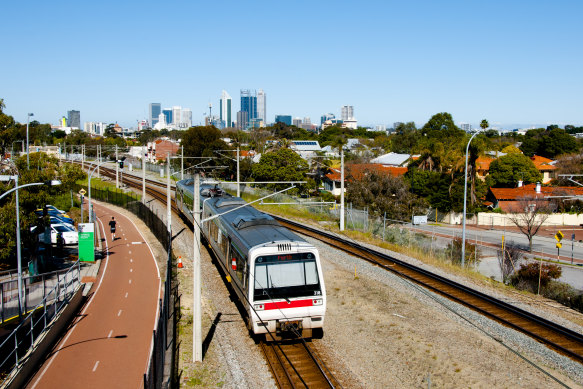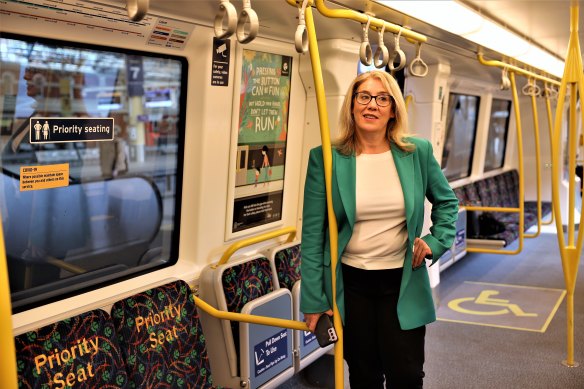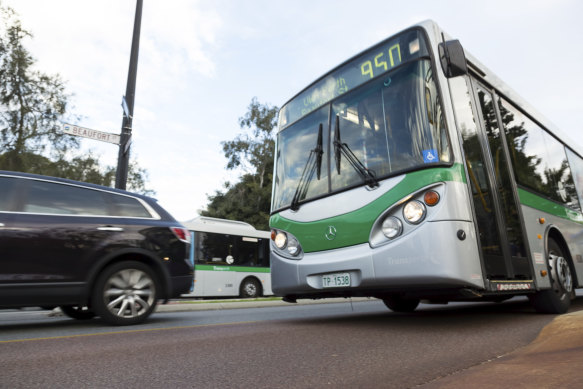In the days after British rock group Coldplay entertains more than 100,000 concert goers at Optus Stadium, there will be another significant event in Perth.
But this one is billed as a disruptive monster set to inconvenience thousands of commuters in a congestion chokehold.

Trains on the Armadale line will stop running until May 2025. Credit: iStockphoto
The Armadale line will grind to a halt in November for a record-breaking 18-month shutdown, pushing 13,000 regular users onto the roads.
The state government says it is the quickest, easiest and safest way to give the 130-year-old train line a $2 billion makeover.
Extensive reconstructive surgery on the line involves the removal of 13 level crossings, construction of seven new stations and the addition of 5.5 kilometres of Perth’s first sky rail through Victoria Park and Cannington. It will also see the line extended to Byford.
But retired rail planner Peter Martinovich, who was the Public Transport Authority’s executive director for infrastructure, planning and land services, has called for a halt to the shutdown. He predicted the project would blow out considerably in cost and time.
“The decision to close the existing railway service for at least 18 months, but more likely three years, and to spend a lot of money on a replacement bus service whilst leaving valuable railway rolling stock idle is a disgrace,” Martinovich said.
“The whole process is most cavalier.”
An exact date for the shutdown will be announced next week, with Transport Minister Rita Saffioti having already confirmed it would begin after ATAR exams end on November 17 and following the Coldplay concerts on November 18 and 19.
The minister stopped short of guaranteeing the project would be completed by May 2025, instead saying she was confident the shutdown would not extend beyond that date.

Transport Minister Rita Saffioti.Credit: Elliahn Blenkinsop
“Some public transport purists don’t support the project, but I was a bit dismayed with some of their analysis in the idea that somehow we could do this during nights and weekends,” she said.
“All these things were assessed, and the reality is, this is the best option to deliver the project in the shortest time frame and protect the safety of the workers. Trying to work with live trains would have meant three years of rolling shutdowns.”
Saffioti looked at the big picture and envisaged a rail network that reached more people and a service where trains ran every few minutes.
“More and more, the turn-up-and-go services are what people are looking for,” she said.
“We’re moving towards that ‘no timetable’ service that if you go to this point, you know there will be a bus or train that rocks up in three to four minutes.”
Liberal MP Tjorn Sibma predicted between 7000 and 8000 extra cars would be pushed onto the road during the shutdown despite a 100-strong “super bus” network replacing the trains.
Sibma said people would likely choose to drive themselves rather than use buses.
“Every single element of the project is delayed by years and years. They’ve effectively bitten off more than anyone can reasonably chew,” he said.
“I’m very, very reluctant to have any confidence that the shutdown will only take 18 months.”
“Public transport has to be quick and reliable to compete with car travel.”
Grattan Institute transport and cities program director Marion Terrill
The initial concept for Metronet, taken to the 2017 state election, came with a $3 billion price tag. The Liberal Party’s calculations now put the project cost beyond $11 billion in construction dollars alone.
Saffioti did not dispute that figure when she sat down with this masthead.
“We’re doing more projects,” she said.
“Metronet has expanded from an initial seven or eight projects to 19 or 20.”
Grattan Institute transport and cities program director Marion Terrill said it was a very unusual approach to shut down an entire train line given the high level of disruption to passengers. She believes the decision is unprecedented.
In Melbourne, the Victorian government is removing more than 100 congested level crossings, but Terrill said that was being done one by one.
“Even that has been quite disruptive with buses replacing trains,” she said.
“There are a lot of complaints about buses – that they are unpredictable and at the mercy of traffic congestion.
“Public transport has to be quick and reliable to compete with car travel.”
Martinovich said the decision to shut the Armadale line favoured the contractor and project managers, with little regard for patrons.
“The public has been sold a pup with this project and public transport users have come off second-best,” he said.
“The minister has said on television that she hopes people will return to the railway once construction is finished.
“That sounds more like a matter of faith and it contrasts with the good, business-based, adage that the most important customer is the one you already have.”
The shutdown comes at a time when patronage is already falling, while peak demand on the road network is increasing.
Saffioti said the extra time people would spend commuting was being eased by delivering express bus services and infrastructure upgrades.
“We’ve surveyed existing users about origin and destination to make sure that our replacement bus services meet their needs,” she said.
“Between Cannington and Victoria Park you already have good bus services and the time differential between catching the train and the bus isn’t that great.
“Through Gosnells, Kenwick and through to Kelmscott we’re very much looking at alternative corridors and making sure that we can get as good a replacement service as possible.”
This includes linking in with train services on the Airport and Mandurah lines.
“The modelling shows that we won’t transfer 100 per cent of train passengers onto buses,” Saffioti said.
“There will be some people that choose to drive but we believe that we can get the majority of people onto our bus replacements.”

A fleet of buses will be rolled out to make up for the Armadale line shutdown. But will commuters use them?Credit: PTA
Roadworks along Albany Highway, Welshpool and Shepperton roads are already under way, preparing for the replacement bus services. The works are due to be completed in November.
Public Transport Authority spokesman David Hynes said the works included new bus priority lanes on busy routes and modifying right turns.
Main Roads has conducted extensive traffic modelling, and new CCTV cameras, electronic message boards and other smart technology will be installed at key locations to give motorists real-time traffic information.
It’s not just the southern transport corridor enduring disruptions to achieve the Metronet vision. Critical works saw a month-long shutdown of Midland and Airport lines in March.
Along the Midland line, the Bayswater station has been closed since April and is expected to remain closed until later this year when part of the new station will reopen.
Its completion is planned to coincide with the opening of the Morley-Ellenbrook Line at the end of 2024.
Martinovich said the minister was relying on the “build it, and they will come” mantra.
“Unfortunately, what the public is now getting are substandard outcomes at premium cost,” he said.
Get the day’s breaking news, entertainment ideas and a long read to enjoy. Sign up to receive our Evening Edition newsletter here.